Rachel,
It has been awhile since I looked, but I think Allcraft had a
selection of stakes. Can’t find their catalog right now, but
will look and post info tomorrow unless someone else has a better
suggestion for you.
Laura
Rachel,
It has been awhile since I looked, but I think Allcraft had a
selection of stakes. Can’t find their catalog right now, but
will look and post info tomorrow unless someone else has a better
suggestion for you.
Laura
Does anyone know a good way to polish stakes. I have a
collection of rough cast stakes. I have a grinder to get the
worst of the rough off. What is a fairly quick way to get a good
finish without spending hours on the polisher?
Richard Whitehouse
UK
Email: riich@rw.clara.net
How about sanding them down until you have a survace that is
ready to polish?
Deb
Richard- You could try what I used to do years back when making
spurs from stainless steel. To get the smooth and rounded edges
and sides, we would do the initial rough grinding as you describe
and then use the large size Cratex wheels to get them smooth and
semi-polished before buffing. Are Cratex available in the UK?
They are a rubberized abrasive wheel, also called Brightboy,etc.
like the small ones used in jewelry work. Good luck-RL
I could do that but they are very hard metal. I think I would be
exhausted if I had to do a lot. I wonder how the manufacturers do
it. I mean polishing, that is!
Richard Whitehouse
UK
Email: riich@rw.clara.net
I think i would consider looking at one of the art metal site
links for on how to polish cast steel .
A belt sander would probably be quickest. For rounded forms you
would want to use a resilient back plate or none at all.
A large buff charged with Greaseless Compound works well on steel
and would give you a very resilient and aggressive wheel.
The problem here isn’t so much the hardness of the material, but
that combined with the scale of the pieces. You’ve got to scale
your up your tools here to match the job. With a decent belt
sander you should be able to get down to 600 finish pretty quickly.
Dick Caverly
Hi Richard,
I could do that but they are very hard metal. I think I would be exhausted if I had to do a lot. I wonder how the manufacturers do it. I mean polishing, that is!
Depending on the shape of the stake & the accuracy required on the
finished item there are several ways industry might polish these
items. Most of the ways require some type of machine, lathe,
cylindrical or centerless grinder.
A way that most folks could use is a belt sander and/or angle
grinder. Th is requires the use of tools generally available (in
the US) at well equiped hardware stores and any industrial
supplier. Belts of different grits are available at these locations
also, however, a better selection of belts is available from a
company specializing in abrasives (look in the Yellow pages of your
phone directory). The majorit y of abrasives (in the US) are mfgd
by 3M or Norton Abrasives.
Depending on the shape & size of the stake, a narrow width (aprox
1", 25m m) belt might be required. If push came to shove, you could
always get abrasives in ‘shop rolls’, various widths by about 50ft
& grind/polish sh oe shine fashon. The final polish can be done
using buffs or a polishing arb or or a right angle grinder.
Good luck!
Dave
richard, try your local school in the CDT dept thay may have a
linisher,(like a belt sander for metal). they may be able to help
P.S. You should be able to rent a belt sander at a tool rental.
DC
Hello every one. I recently purchased a set of stakes from a jeweler
who had retired. He said he’d gotten them in Sweden when he learning
to be a goldsmith. Most of them I am familiar with,but there is one
that I’ve never seen before and can’t seem to get on.
Its the one with the single picture. Any help will be greatly
apprieciated. Thanks Sheri
Hello every one. I recently purchased a set of stakes from a jeweler
who had retired.
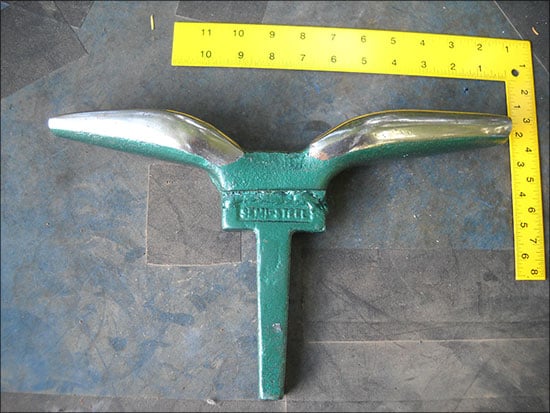
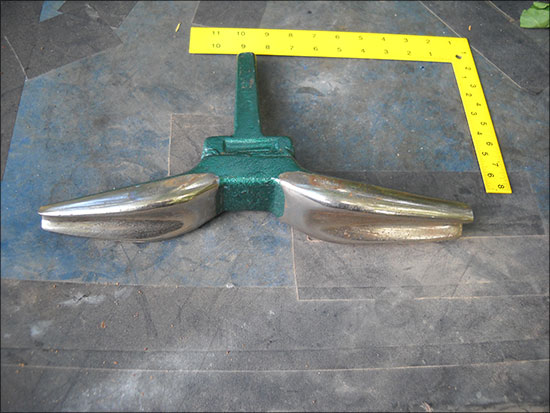
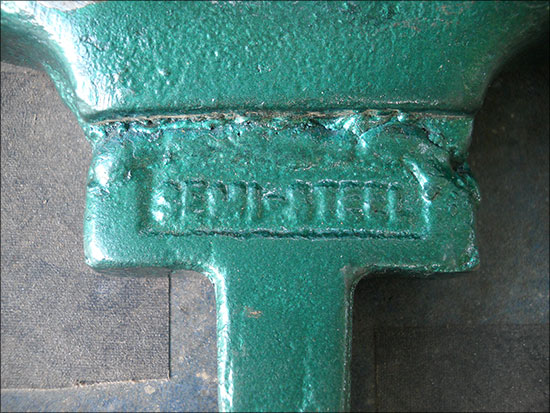
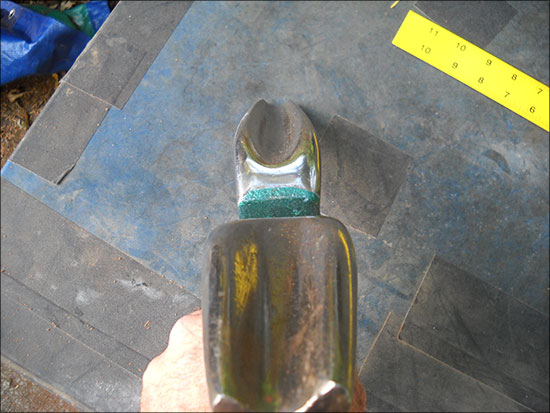
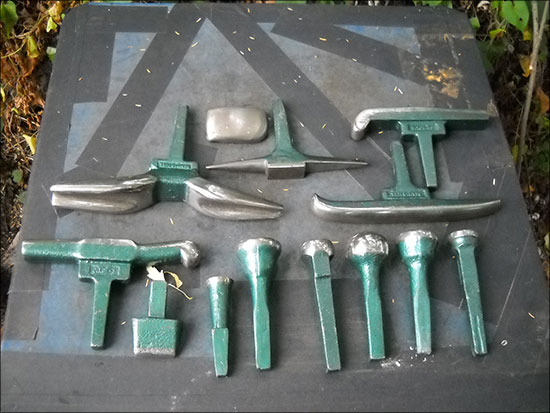
He said he’d gotten them in Sweden when he learning to be a
goldsmith. Most of them I am familiar with,but there is one that I’ve
never seen before and can’t seem to get on. Its the one
with the single picture. Any help will be greatly apprieciated.
Thanks Sheri
I’d be interested to find out also, it looks like a concave stake to
me. CIA
This is a crimping stake. It is used when raising hollow ware.
Most of them I am familiar with,but there is one that I've never seen before and can't seem to get on.
It’s a crimping stake. In raising holloware, one method of angle
raising used is to hammer radial crimps, or shallow waves/folds, into
the metal. Kind of like a paper cupcake liner. That holds the metal
at a new higher angle. Then, using smooth raising stakes, the crimps
are hammered in, upsetting the metal into itself, resulting in a
smooth surface to the metal, now at the higher conical angle to the
base, slightly thicker or stretched outwards. Anneal, repeat… Your
stake is made for putting in those crimps. Many metalsmiths do it
over wooden crimping stakes rather than steel, as it results in fewer
tool marks in the inside of the piece. But the steel stakes are
handy, and can be used for other shaping tasks as needed.
Peter
Hi Sheri,
As Peter and others have already noted, the funny one’s a crimping
stake. Used exactly as Peter described. Just FYI, all the stakes
look like Dixon stakes, made in the US, so he probably got them once
he got over here. (Or, rather, I can tell you where they were made:
USA. Where they got shipped to before he got them is an open
question, but it’s unlikely they went all the way to Sweden and
back.)
FWIW,
Brian
That stake is for fluting, making furrows in the piece of hollow
ware. Nice stakes. You will be able to do some wonderful
silversmithing with that assortment. Hope you make use of them. If
you decide you don’t want them… let me know.
-Nancy Linkin
Hi Sheri
You’ve got your mushroom stakes, 2 raising stakes, a crimping
raising stake and a combo ring and tapered square stake. I’ve used
them all when learning silversmithing at RISD many years ago. The
forging room was so full of stakes, some had never been used in
years. I never learned to raise by crimping, just straight raising,
and raising without the crimps was more logical to me. Raising came
naturally to me - I taught myself how to raise. I rarely do it now,
but will do it as a demo for my classes. I do a lot more sinking
now.
You are lucky to acquire them. The old ones get harder and harder to
find. Most of mine are old, or when I bought them back in the 90’s.
Take good care of them, cover them so they don’t rust, or pit, and
use them when you can.
Joy
Thanks, Its so nice to have people to ask about this stuff. I’m
fairly new at this and had no idea what that one was used for. Sheri